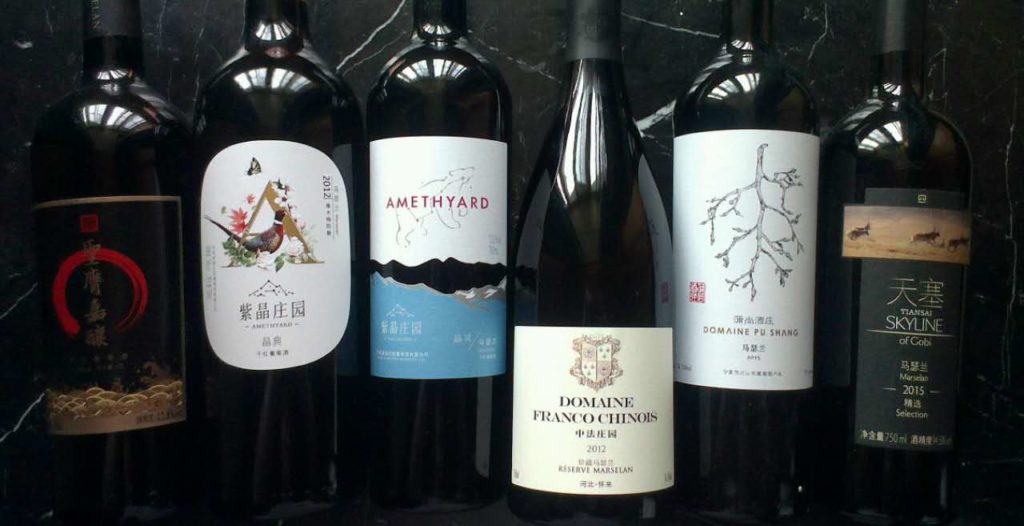
By Jim Boyce | Last year, I interviewed Australian Mike Gadd about the wines, vineyards and grapes of Ningxia as we drove about the region in the delivery van of WENS, the company for which he consulted. Gadd, among the 48 contestants from 17 nations in the Ningxia Winemakers Challenge from 2015 to 2017, has since shifted to Shepherd winery so I asked him for an update, including about different “terroir’ and why he recently used a pasta strainer to make wine.
(Also, check out this Q&A I did with fellow contestant Denise Cosentino, who is making wine at Chateau Nine Peaks in Shandong.)

Boyce: You’re at a new winery this year?
Gadd: It’s a new small winery owned by a young couple named Zhang Da Wei and Shi Yue, and their families, that is going to be called Shepherd (牧童酒庄). It’s named after a famous poem from the Tang Dynasty about the life of a shepherd boy, living away from the bustle of the big cities. The owners reckon it reflects the life in Ningxia.
It also happens to fit my wine-making philosophy. That is, I’m more trying to “shepherd†or guide the grapes to wine, rather than bend them to the will of some international recipe. So far, I’ve been able to act minimally on the fruit I’ve had, so it rings true.
The winery is small, at most 60 tonnes, with a vineyard of 100 mu (seven hectares) just being planted. We’re buying fruit at the moment, but will be mostly self-sufficient in years to come. I’ve recommended Cabernet, and a trial of Malbec and Marselan to see how they go.

This is your fifth harvest in Ningxia. How were the grapes this year?
This is probably the cleanest fruit I’ve seen in Ningxia. By that, I mean disease free. That fact alone doesn’t qualify it as “best vintage ever” as some are spruiking — that claim annoys me when made before even a grape has been crushed — but the indicators are good.
Those who managed the crop levels should see some nice flavours. Sugars got up early in some places, so getting flavour and tannin ripeness and alcohol balance will present a challenge for some. And there still is a lot of winemaking to go. As they say, “the proof of the pudding is in the eating.” I’m quietly confident that there will be some good wines from Ningxia this year. Watch this space.

As quality increases, we’re seeing regional differences, not surprising given wineries extend over 100 km from north to south. What differences do you see between WENS and where you are now, further north and closer to the Helan Mountain range?
It’s been great to see fruit from Jinshan in the north, Hao Yuan Village in the middle, and Ganchengzi (Qingtongxia) to the south. I tend to describe fruit in terms of music. I would say the Jinshan fruit is prettier, with more floral and high notes, more treble so to speak. Ganchengzi tends to have a heavier bass, with darker bramble and plum notes. In a clean year like this one, and without any winemaking artefacts, like tannin or oak dust, you can start to really see the difference.

Marselan. Everyone’s talking about it. What’s your take? And would you rather have it or Cabernet Gernischt as “China’s grape’?
It’s hard to say as it’s early days. As a variety, sure, it’s black in colour, which is important in China right now, but does it have international quality? I’ve seen a few decent ones, but some have been hollow, high-alcohol wines with too much winemaking affectation, such as added tannins. I’ve seen way more good Cabernet Sauvignon.
I’m personally not a fan of the whole idea of rushing to get this thing called “China’s Grape.” [I am!–Boyce] Why don’t we have some patience and let serendipity do its job. It was centuries of that very thing that created all of Europe’s classic regional and varietal pairings. [Because I won’t live that long and speculation is fun!–Boyce]
Even in places like the Barossa in Australia, Shiraz took over a century to become what it is today. The Australian Government was even paying farmers to pull it out in the early 1980s. It’s as though here in China, it has to be declared right now, and it can’t possibly be anything that somebody else has. France already having Cabernet, Shiraz, Sauvignon Blanc, Pinot Noir, and so on, didn’t stop places like Barossa, Margaret River, New Zealand and Napa Valley from making world-class wines from them. [Cabernet Sauvignon is already the most planted grape in China!–Boyce.]
I think everyone needs to take a chill pill and see what shakes out over the next few decades. I understand the commercial pressures of the modern environment don’t suit serendipity, but let winemakers have some time to use trial and error to see what works. Let’s also see what the consumers both locally and internationally start trusting and drinking. [But you still think Marselan is better than Cabernet Gernischt, right? Tell me that much! We almost died while winter mountain climbing in Ningxia together! JUST ANSWER THE QUESTION!–Boyce]
I saw on WeChat you were getting pretty creative with your winemaking. What was going on there?
Just trying to use what I have available to get things done. I’ve worked in some pretty remote places, and you have to make do with what you’ve got, especially when owners don’t have a bottomless pit of money to buy every new gadget under the sun.
I also like to work minimally, so getting air into the ferment to keep things fresh and the yeast happy, is better in my eyes than adding things like diammonium phosphate, which is what most commercial yeast nutrients contain. The air also helps with phenolic integration.
Strapping a noodle strainer to a hose seemed like a good idea. It worked brilliantly. Now I’ve actually welded it all together and it’s our own piece of original kit. And only cost 30 kuai! Beat that Vaslin Bucher!

Sign up for the Grape Wall newsletter here. Follow Grape Wall on LinkedIn, Instagram, Facebook and Twitter. And see my sibling sites World Marselan Day, World Baijiu Day and Beijing Boyce. Grape Wall has no advertisers, so if you find the content useful, please help cover the costs via PayPal, WeChat or Alipay. Contact Grape Wall via grapewallofchina (at) gmail.com.
Leave a Reply
You must be logged in to post a comment.